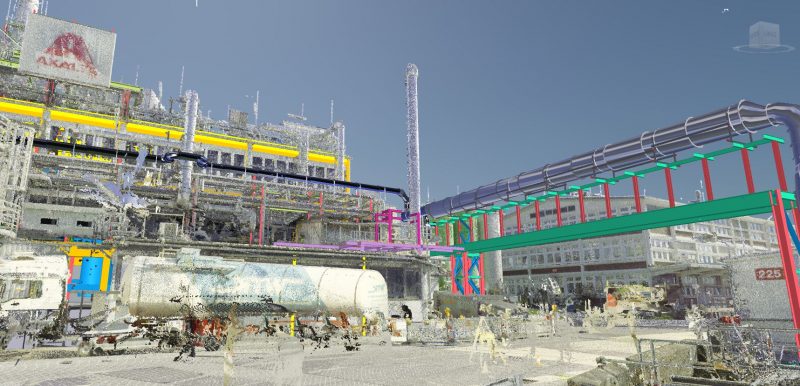utodesk University starts October 5
If you haven’t heard, registration for Autodesk University 2021 (AU) is now open! The much-anticipated conference is fully digital, no cost to attendees, and kicks off on October 5 with hundreds of expert-led classes. This year’s virtual event rallies around one unforgettable theme:
Don’t wait for progress. Make it.
No matter where you’re at in your construction career, or what business goals you’re out to achieve, get ready for a set of construction classes designed to leave you with a long list of actionable takeaways. AU 2021 has been crafted to help you connect your processes, automate workflows, and unlock highly valuable insights—all of which give you significantly more confidence in decision-making.

With over 80 construction classes available this year, the question remains: what sessions should you attend? While dates and times are still being confirmed, we’ve put together a list of some of the most anticipated construction sessions at Autodesk University 2021. We recommend registering for AU 2021 to receive this year’s official schedule as soon as it’s released.
Jump to classes by process/topic
*Dates and times are still being confirmed
Leveraging data and connected constructionThe preconstruction processConstruction, jobsite, and built environmentsThe future of BIM and project managementIndustrialized construction Diversity and inclusionSustainable building
Leveraging data and connected construction
Construction projects are increasing in complexity. More people are involved, plus we’re collecting vast amounts of data. For this reason, AEC professionals must ensure that their data, processes, and teams are tightly integrated. These classes can help you do just that.
Register for Autodesk University >
Back to class topics >
1. Data in the AEC Lifecycle: Using Data to Better Connect AECO Stakeholders
Speaker: Lauren Collier, SSOE Group
Calling all architects, engineers, contractors, and owners: This session is perfect for anyone who wants to better understand the value of collecting data across enterprise and connected cloud environments. Massive amounts of data are created from project inception to design, planning, building, closeout, operations and beyond. The challenge, however, is that construction professionals often struggle to leverage this information to make great strategic decisions—and confidently inform stakeholders.
You’ll hear from Lauren Collier at the SSOE Group as she shares:
How collecting and using data through the lifecycle of a project can help teams stay on schedule and maintain costsThe potential value in analyzing data and how you can use it to drive better decision-makingThe additional infrastructure needs or talent required to be successful in life-cycle data collection & analysisThe importance of aggregating data across a connected cloud environment
2. ERP Integrations for Autodesk Construction Cloud
Speakers: Josh Cheney, Senior Manager of Strategic Alliances at Autodesk – Michael Newland, Director of Product Management, hh2 Cloud Services – Sophat Sam, Integration Solutions Engineer for Autodesk Construction Cloud
Autodesk University 2021 will be full of plenty of exciting announcements including our new integrations between Autodesk Construction Cloud and Construction Accounting Applications. We’ll walk through hh2’s integration between Sage CRE 300 and Autodesk Build as well as Quickbooks Online, which integrates with Autodesk Build using ACC Connect.
The speakers will share what makes the integrations so useful, share their availability, and highlight which ERPs integrate into Autodesk Cost. You’ll also have the opportunity to connect with some construction-accounting system integrators for deeper learning.
3. Importance and Effect of Standards in Construction
Speaker: Angela Yee, Senior Product Manager at Autodesk
Join Angela Yee, Senior Product Manager at Autodesk, for an informative discussion on prominent construction standards, such as ISO 19650, and how they’re being adhered to across the globe. You’ll learn how these standards can affect business practices and the ways teams are navigating these changes.
This session will also share how construction technology can help teams adopt new workflows put in place by the changing standards.

4. Successful Digital Transformation through a Product Management Organization
Speaker: Anna Lee, Product Manager, McKinstry
In this upcoming AU session, McKinstry will share how it advanced its digital transformation by leveraging its Product Management Organization (PdMO) this past year. As Dace Campbell, Director of Project Management in Construction shares the McKinstry story, you’ll discover how other AEC firms can apply product management best practices to support their own digital transformation.
This session is jam packed with insights into successful digital transformation; some of the key highlights include:
How PdMO offers agility and adaptability to meet the needs of an evolving market and converging industriesWays to develop and implement product roadmaps to prioritize and manage a portfolio of cross-enterprise initiativesHow PdMO ensures alignment between the technical roadmap and business needs, and measures the impact of technologyBest practices for change management to meet strategic and business goals
5. Implementing Autodesk Construction Cloud Across a £2 Billion Business
Speaker: Ivana Tudja, BIM and Digital Engineering Lead (Senior BIM Manager), Mace
Implementing a new solution is almost always challenging. Change is inevitable but not always well-received. This session shares actionable insights for leveraging innovation in the construction industry and getting your whole team on board. You’ll learn how to not only introduce and implement Autodesk Construction Cloud but also inspire your team to embrace the technology
Don’t miss this case study on the well-implemented use of Autodesk Construction Cloud. Ivana shares how Mace saved 50% of their time spent on coordination and reporting by using BIM 360 Document Management and Model Coordination. You’ll walk away from the class with an understanding of how to:
Develop a strategy for implementing Autodesk Construction Cloud in your companyIdentify uses for different parts of Autodesk Construction Cloud and the Assemble platformUse the product to improve coordination and drive efficiencies on-sitePinpoint training requirements and deliver the right training for your users
Return to class topics >
The preconstruction process
Many factors that influence a project’s success are determined well before you enter the jobsite. How you approach the preconstruction phase—which involves ironing out your plans, designs, and documentation—can make or break the ease in which you move through a project. The following sessions will teach you how to improve your preconstruction processes for better outcomes.
Register for Autodesk University >
Back to class topics >
6. BIM Collaborate: Bringing the Distributed Team Together
Speaker: Matt Anderle, BIM Director at AECOM
Join Matt Anderle, BIM Director at AECOM, as he highlights the evolving possibilities provided by Autodesk BIM Collaborate & BIM Collaborate Pro. These cloud-based collaboration services enable teams to execute projects with unprecedented access and control for team integration.
In this session, you’ll experience common project workflows and hear from experts on the best approach for migrating your next project to the cloud. As one of the leading consumers of Autodesk Construction Cloud services (with over 3,000 active projects) AECOM is ready to share successes and challenges their team has experienced along the way.
You can expect to walk away from this informative session with the following takeaways:
Insights into the enhanced capabilities of BIM Collaborate / BIM Collaborate ProHow to’s for leveraging permissions for document control and securityUnderstanding design collaboration workflows across a distributed teamBackground into integrated methodologies for tracking changes and model coordination review
7. Collaborative Estimating Workflows for Preconstruction and VDC Teams
Moderators: Rachel Trocchi, Technical Solutions Executive, Autodesk – Sarah Cunningham, Senior Product Manager at Autodesk
Panelists: Prashant Sharma, DPR Construction – Jacob Skrobarczyk, DPR Construction – Amr Raafat, Windover Construction
BIM and VDC managers, here’s one preconstruction session you can’t miss. Sarah Cunningham, Senior Product Manager at Autodesk, will lead this panel discussion with BIM/VDC managers from leading construction companies. You’ll learn the latest strategies and best practices for getting the most out of collaborative, 2D and 3D quantification workflows.
Participants will leave the session with an understanding of how:
Construction firms are leveraging advanced 3D quantification workflows How to overcome internal resistance around using 3D models for quantity takeoffAutodesk Takeoff and Assemble can be used in quantity takeoff workflows
You’ll also hear bright ideas for helping teams successfully ease into new ways of performing quantity takeoff.

8. Conditioned BIM Data Powers Connected Construction
Moderator: Nathaniel Coombs, Senior Business Consultant, Autodesk
Panelists: Jourdan Trice, DPR Construction – Badri Sarangi, vConstruct Pvt. Ltd. – Matt Roberts, Gray – Tomislav Zigo, Clayco – Liang Gong, Clayco
BIM and VDC managers serve a pivotal role in empowering stakeholders across multiple disciplines and teams to fully leverage the BIM data stored in the model. Design models often lack construction data needed for downstream use, but a conditioned and structured model that has customized information added can result in a model that can be utilized from design to construction to handover. Currently, teams are faced with siloed solutions that force them to maintain multiple sources of truth for project documents at different project phases resulting in heightened confusion.
In this panel, we will cover how project teams can incorporate integrated workflows with Autodesk Assemble and facilitate collaboration between project members.
9. Leveraging BuildingConnected to Enhance Your Digital Bid Process
Speaker: Ariel Castillo, Strategic Process and VDC Specialist at Miller-Davis Company
Over the last year, the construction industry has completely restructured the way we do business in order to thrive. The preconstruction phase is no stranger to changes with restrictions on in-person bid openings forcing the industry to reevaluate how to conduct bids.
Ariel Castillo, Strategic Process and VDC Specialist at Miller-Davis Company, will share how tools like BuildingConnected are revolutionizing the way we conduct the bidding process and connect with subcontractors. During this session, you’ll uncover how construction firms can benefit from a digital-streamlined bidding process and a real-time construction directory. Ariel will share his tips and tricks for fostering relationships with all stakeholders and minimizing risks for future projects.
If you want to learn more about navigating BuildingConnected’s user interface and how to leverage the largest real-time construction network, block out time on your calendar for this upcoming Autodesk University session.
Return to class topics >
Construction, jobsite, and built environment processes
When it comes to the field, how do you ensure that your plans are executed without a hitch? The future of jobsites is here. The sessions below are designed to help you clear a path so you can complete projects on time and within budget
Register for Autodesk University >
Back to class topics >
10. Finish on Time Every Time: Optimize Work Planning and Master Scheduling
Speaker: Shani Sharif, Senior Product Manager, Autodesk
Planning and scheduling are key when it comes to ensuring that projects are completed on time. However, there’s a bit of a disconnect between the master schedule of a project and the weekly work planning that happens in the field. While the former is created by scheduling experts, the latter is handled by the superintendent and the trades.
In this talk, the team at Skanska will discuss how they leverage these schedules to find a balance between the two. They’ll share how they’re utilizing master schedules to gain a high-level view of time and resource requirements. They’ll also talk about how short-term work plans enable them to reduce waste with collaborative project planning and daily progress monitoring.
This class will show you that the key to better project planning is effective connectivity and a smooth flow of data between short and long-term schedules.
Attendees will also learn how to use Schedule and Work Plan in Autodesk Build to manage project-level schedules and weekly work plans on a unified platform.
Don’t miss this class if you’re looking to:
Understand the benefits of data flow, connectivity, and improved communication around short and long-term schedulesDiscover best practices to determine the granularity in the master schedule vs. the detail needed at the work planning levelSee how teams leverage Work Plan in Autodesk Build for remote and in-person collaboration Learn how to empower project teams by sharing, communicating, and connecting the long term schedule in Autodesk Build
11. The Future of Visual Progress Tracking and Documentation in Construction
Speaker: Alix Cohen, Product Manager, Autodesk
Being able to consistently track the work done on a project is in everyone’s best interest. Not only does it provide visibility on the progress of a project, but it’s also necessary for subcontractors to get paid.
However, tracking work progress in detail is easier said than done. Construction projects have plenty of moving parts, not to mention, several stakeholders involved. There isn’t always a straightforward process for logging data and tracking progress.
This talk will show you how to address these issues with help of technology. Solutions like Photos and Progress Tracking workflows enable you to better monitor how projects are doing, so you always have an idea of the work that’s been completed and what needs to be done.
When you attend this session, you’ll walk away with:
A solid understanding of why progress tracking matters and how it can keep your project on schedule and within budgetUse cases presented by industry leadersKnowledge on where to go to get started with progress tracking on your projects

12. How to Exceed Project Profit Margins by Leveraging Data & Workflows
Speaker: Dane Pemberton, US Group Construction Technology Manager at BL Harbert International LLC
Staying on budget is a top priority for construction teams. As such, construction managers and planners are often pressured to constantly maximize profitability.
The good news: there are several ways to accomplish this. By streamlining your workflows, connecting your data, and leveraging project insights, you’ll be able to reduce waste, improve productivity, and widen your profit margins.
This session will dive deep into how to do all of the above. Specifically, you’ll learn:
How to create processes to eliminate bottlenecksHow you can establish clear accountability across teamsHow to connect workflows and data to cost activitiesHow to analyze data to proactively mitigate risk
13. Structured Curiosity: The Keys to Unlocking Efficiency within Your Processes
Speaker: Hamzah Shanbari, Manager, Construction Technology & Innovation, The Haskell Company
James Cameron had a point when he said, “Curiosity is the most powerful thing you own.” Being curious keeps people open to new ideas and ways of doing things, which then paves the way for innovation.
No one understands this better than the team at Haskell, a North American general contractor. In this session, Hamzah Shanbari, the company’s Manager, for Construction Technology & Innovation, discusses how they harness people’s curiosity into an agile process evaluation that allows them to gain actionable insight from their data.
He’ll also discuss how they effectively communicate it to stakeholders and make strategic decisions that improve their projects.
Attend this class to get a closer look at their process and learn how the folks at Haskell:
Implement strategies to increase transparency and client satisfactionDeliver a higher quality turnover package and closeout experience to their clientsIncrease their chances of winning repeat business by understanding client needs
Return to class topics >
The future of BIM and project management
If you want to learn more about what’s next in the realm of Building Information Modeling (BIM), be sure to check out these classes. They offer helpful perspectives on BIM and give you a look at game-changing innovations happening within the space.
Register for Autodesk University >
Back to class topics >
14. Panel: Conditioned BIM Data Powers Connected Construction
Moderator: Nathaniel Coombs, Senior Business Consultant, Autodesk
Panelists: Jourdan Trice, DPR Construction – Badri Sarangi, vConstruct Pvt. Ltd. – Matt Roberts, Gray – Tomislav Zigo, Clayco – Liang Gong, Clayco
BIM and VDC managers serve a pivotal role in empowering stakeholders across multiple disciplines and teams to fully leverage the BIM data stored in the model. Design models often lack construction data needed for downstream use, but a conditioned and structured model that has customized information added can result in a model that can be utilized from design to construction to handover. Currently, teams are faced with siloed solutions that force them to maintain multiple sources of truth for project documents at different project phases resulting in heightened confusion.
In this panel, we will cover how project teams can incorporate integrated workflows with Assemble and facilitate collaboration between project members.
15. Construction Sequence Animations
Speaker: Ryan Taube, Director of Design Technology, Clayco
Construction sequence animations can be complex, but they don’t have to be. In this session, you’ll get a proper look at the steps involved in planning out an animation. You’ll also see which tools are best suited for the job and how to effectively divide the labor.
Geared towards 3D modelers, animators, architects, and BIM/VDC managers, this class will walk participants through the process of effective construction sequence animations. You’ll learn what info to obtain from the client, how to review camera matching drone footage, and how to implement the workflow from Revit to 3ds Max.
Most importantly, you’ll discover how to manage the entire process and ensure that everyone is working towards the same goal. Speaker Ryan Taube will diagram the entire process so you can see how everything flows.
Some key takeaways from this session include:
Planing out a construction sequence animation and knowing what questions to ask before starting The basics of the Arnold renderer and how to effectively utilize itBuilding a quality material and model library Managing your team’s time with clear expectations and divisions of labor

16. Ten Points of Excellence for VDC MEP Coordination: A Subcontractor’s Lens
Speaker: Bryan Strecker, Senior VDC Engineer, VIATechnik, LLC
VDC is rapidly being adopted across the AEC field. We’re experiencing massive changes when it comes to MEP coordination, and industry players are still figuring out the best practices for efficiently utilizing BIM. This class looks at ten different strategies for improving the coordination process—but from the perspective of an MEP coordinator.
It’s often believed that speed and efficiency in coordination are driven by the project coordinator. However, subcontractors also play a pivotal role and can add tremendous value.
This is an excellent class for BIM/VDC managers, electrical detailers, and subcontractors. Not only will you learn about MEP coordination from the subcontractor’s perspective, you’ll also discover how to use Revit and Fabrication CADMEP to achieve a high level of detail in the coordination process.
This session will teach you:
Ten (10) effective strategies for enhancing the coordination processHow to utilize Revit for MEP Coordination, attaining LOD400How to influence the coordination process to better fit your needsHow to better understand the subcontractor’s role and how they can consistently add value to the project
17. The Benefits of Automated Model Checking in the Cloud
Speaker: Brendan Dillon, Manager of Digital Facilities & Infrastructure, Denver International Airport
Want to find out more about automated model checking? Then mark your calendar for this panel discussion. We’ve brought together building owners and design firms to share how they’re benefiting from automated model checking.
Panelists will talk about how they’re reviewing their Revit models in BIM 360, the steps they take to generate reports on fidelity issues, and how they’re utilizing that data in dashboards.
The panel is composed of a diverse group of experts — including a building owner (Denver International Airport), as well as large and small design firms. You’ll also hear from the team responsible for the Model Checker on Revit and the Model Checker on Forge (CADD Microsystems).
Facilitated by an architect on the Autodesk team, this panel will inform you about the benefits and results that different project stakeholders can achieve by implementing automated model checking.
Catch this panel discussion to:
Understand how automated model checking is being used in the industryHear how building owners with modeling requirements are benefitting from working with their consultantsSee the advantages that large consulting firms get from working with building owners and their modeling requirements Discover how small/medium consulting firms can benefit from automated model checking
Return to class topics >
Industrialized Construction
Industrialized construction (IC) methods have proven to be efficient and cost-effective. If you’re planning to implement IC in your projects, the sessions below will give you more information on how to do it right.
Register for Autodesk University >
Back to class topics >
18. Bridge the Construction/Manufacturing Gap with Inventor Product Templates
Speaker: Andy Akenson, Software Architect, Autodesk
A lot of time and resources are wasted doing the repetitive work required in creating mechanical product templates for consumption by design and construction.
Fortunately, there’s a better way. By shifting from a “creating projects” mindset to one that’s focused on “creating products,” you can use business logic and fabrication rules to improve the construction process.
This session will shed light on how to do this successfully through best practice tips and real-world examples. An actual Autodesk customer will take the stage to share their experiences in their journey towards smarter, more scalable, repeatable processes.
Recommended for architects, BIM/VDC managers, engineers, and fabricators, this session will show you:
How to create a more collaborative working relationship between designers and manufacturersHow to successfully start looking at prefabrication as a product and not a projectHow to build product templates that you can reuse on relevant projectsThe entire process in action, so you can learn Autodesk’s best practices for template building
19. Leveraging Data & Strategic Partnerships to Drive Prefabrication
Speaker: Brandon Johnson, Director of Electrical Engineering, KLH Engineers
The word “data” gets thrown around a lot, but how do we actually use it to unlock quality and efficiency gains in construction? The answer lies in having strong strategic partnerships that are centered on leveraging data.
With the right partners, you can better utilize data to reduce overwhelm, solve problems, and drive better outcomes.
This session will show you the advantages of developing data-centric partnerships with like-minded organizations. You’ll see how custom software development within the Revit API can streamline data flow and solve age-old industry frustrations. Plus, you’ll learn how information can be fed from the design phase into prefabrication.
The session will also cover case studies illustrating these tactics so you can see the results generated by having strong partnerships.
Don’t miss your chance to learn:
How to identify situations where leveraging data can have significant benefits on project quality and efficiency How to seek out and collaborate with like-minded partners to drive change How to leverage design data in the prefabrication process How to utilize the Revit API to streamline data flow between partners and design/prefabrication phases

20. Optimizing Your Business Around Industrialized Construction
Speaker: Ryan Mcmahon, Director of Product, Industrialized Construction, Autodesk
The construction industry is facing massive changes and challenges. Between labor shortages, supply chain disruptions, and massive population growth, AEC professionals need to come up with new ways to design and build.
Accomplishing that starts by going from a “project” mindset to a “product” mindset. This shift will streamline the architectural design process, allow subcontractors to start fabrication faster, and enable teams to standardize and scale their overall ability to produce predictable work.
In this session, Autodesk’s top thought leaders in Industrialized Construction—along with their most innovative customers—will spend time discussing how to successfully shift a business to align with these new developing industry trends.
Be sure to attend this class in order to:
See how industrialized construction makes the architectural design process more efficientFind out how to start fabrication faster and respond to bids soonerLearn how IC will save you time, reduce material waste, and improve safety
21. Digital Transformation in the Construction Site
Speaker: Takaaki Miyauchi, Managing Director, Daiwa House Industry Co.Ltd.
In this class, Takaaki Miyauchi will discuss how the teams at Daiwa House Industry Co. Ltd digitized their manual and paper-based processes. In their journey towards digital transformation, the team had to deal with issues like inefficiencies, as well as siloed software and processes.
Find out how they solved these challenges using a common data environment (CDE) and other digital tools.
This session will teach you all about:
Identifying key factors in digitalization of construction siteDefining how information should be linked between CDE and the construction site Applying various use-cases of PlanGrid to many on-site tasks other than inspection
Return to class topics >
Sustainable building
Building materials are finite, so the construction industry will inevitably lean on smarter and more sustainable solutions. Here are several sessions, from AEC leaders, who are using technology to aid in sustainable design, navigating the impact of climate change on construction, and finding creative ways to reduce carbon footprints.
Register for Autodesk University >
Back to class topics >
22. BIM 360: The EC3 Plug-in Helping Teams Save Time and Cut Carbon Impact
Speaker: Myrrh Caplan, Sustainability Director, Skanska USA
Sustainability continues to be at the forefront of people’s minds, particularly in the construction industry. As the corporate world grows ever more conscious of its impact on the planet, AEC firms are putting more focus on reducing their carbon footprints.
One tool that can help you do just that is Embodied Carbon in Construction Calculator (EC3). Developed by Skanska with Autodesk, Microsoft, and the Carbon Leadership Forum, EC3 empowers preconstruction teams to compare emissions and embodied carbon levels for proposed project materials.
When used together with Autodesk and other tools, EC3 can weigh embodied carbon impacts with schedule, budget, and constructability simultaneously. Teams can use the EC3 tool to collaborate with owners and design teams when selecting materials with lower embodied carbon, often at no additional cost.
In this class, our team will demonstrate how to import and analyze data using EC3, ultimately building with a lower carbon footprint.
Attend this session to learn all about:
Implementing the Embodied Carbon in Construction Calculator (EC3) tool and its recent updates to lower carbon footprintsMaking EC3 more efficient through the BIM 360 interfaceNavigating the EC3 plug-in interfaceHow to communicate with others in your organization or externally on the ability to upload into EC3 from BIM 360
23. How Building Engineers Can Lead on Climate Change Reduction Actions
Speaker: Tony Saracino, Senior Sustainability Success Manager, Autodesk
The United Nations predicts that the population will increase from 7.5 billion today to nearly 10 billion by 2050. This means that we need to construct an average of 13,000+ commercial buildings daily in order to keep up with the population growth.
This can have dire effects on the environment. It’s estimated that construction projects contribute 40% of the waste in landfills. What’s more, buildings produce one-third of the global greenhouse emissions and use 40% of global energy.
Suffice it to say that these figures aren’t sustainable, which is why the AEC industry must rethink how it designs, constructs, and operates buildings.
If you’re looking for ways to improve sustainability in your construction projects, be sure to join this lively panel discussion. Experts and key industry leaders will explore how the structural and MEP engineering industries can help address the climate crisis and build a better future for everyone.
In this interactive session you will:
See how building engineering can help reach net-zero carbon for new buildings using existing, proven technologiesExplore how engineering can support the circular economy by emphasizing renovation and refurbishment over new construction Talk about how digital transformation at your firm can accelerate carbon reduction Join the conversation about how industrialized construction can assist in reaching climate change reduction goals
24. Mass Timber and Modular MEP: A Case Study for Integrated Project Delivery
Speaker: Anders Carpenter, Senior Associate, Perkins & Will
Mass timber structures, modular MEP, and façade systems are becoming more prevalent, and for good reason: they help you design beautiful and sustainable buildings on time and within budget.
Attend this session to learn how a mid-rise housing project utilizes mass timber and modular MEP / facade systems to reduce its carbon footprint and costs, compared to a traditional concrete structure. This case study offers a roadmap for how integrated delivery can decrease operational and embodied carbon by 60% and reduce costs by 10%.
Panelists will discuss how owners can influence integrated delivery adoption and the best practices you should implement to facilitate a smooth process.
Some key learnings include:
Identifying design and sustainability benefits of mass timber and modular MEP / façade systems Comparing the impact mass timber / modular MEP with traditional concrete structuresAssessing what is needed for this type of integrated project delivery collaboration Identifying the value of shared data sets and models between the design team, fabricators, contractors, and owners

25. Leveraging BIM360 Beyond Construction to Develop Paperless Operations
Speaker: Elsie Kiema, Design Engineer, Sanergy Inc.
Cities are growing faster than ever and urban population growth is dramatically outpacing access to basic services. Because of this, municipalities must find more efficient sanitation and waste management solutions.
To that end, Sanergy has developed an innovative model to treat and convert sanitation and organic waste into animal feed, using insect rearing technology.
Here to talk about how they did it is Elsie Kiema, Design Engineer at Sanergy. She’ll share how they built the largest (and first of its kind) organic waste recycling facility to solve Nairobi’s waste management crisis and scale the production of insect-based animal feed.
As Sanergy enters the next phase of its growth, the company plans to replicate the solution in other cities using BIM360 for the design, construction and operation of new factories.
This talk will take you through the successes and challenges of the facility’s equipment handover process and how BIM360 played a key role in the transition to operations. The session will also touch on how Sanergy intends to use Autodesk products in the next factory design cycle in 2021.
A must-attend for CAD/CAM professionals, industrial designers, and quality managers, this class will teach you how to:
Leverage BIM360 to streamline equipment commissioning and handover activities Track design functionality and specifications after handover for the replication of improved designs Adopt BIM360 as an on-site asset management tool Build a complete design and construction project cycle within BIM360
26. A Digital Revolution in Resilient Housing, Build Change and Autodesk
Speaker: Juan Caballero, VP of Programs – Latin America and The Caribbean, Build Change
Build Change has been using Autodesk products for nearly two decades. From designing retrofits in AutoCAD to automating Revit with Dynamo, and now implementing Forge, the company strives to revolutionize resilient infrastructure, particularly in the housing sector. With the help of Autodesk tools, Build Change has been making home retrofits safe and possible in the COVID-19 era.
Needless to say, the company has gone through a lot over the last several years. In this session, Juan Caballero will walk you through Build Change’s 17-year history of using Autodesk. Discover how they’ve managed to impact 600,000 lives across 24 countries by providing an integrated solution for improving the resiliency of infrastructure. They are also empowering communities and to mitigate disasters and improve their essential functions.
Key takeaways from this session include:
Understanding how ADSK products can impact infrastructure resilience, particularly in housing in emerging marketsImplementing digital solutions for infrastructure resilienceSolving bottlenecks in the construction value chain using digital tools
27. Using Technology and Software to Create More Sustainable Designs
Speaker: May Winfield, Global Director of Commercial, Legal and Digital Risks, Buro Happold
Sustainability in construction is a complex topic and there are many questions on how to actually implement it. Technologies like Autodesk’s AEC Collection and Construction Cloud are key pieces that can help you solve the sustainability puzzle. Here to talk more about this topic is May Winfield from Buro Happold.
Known for its technology-forward thinking, Buro Happold has long been working towards an equitable and green recovery to mitigate climate change and the biodiversity crisis. The firm envisions a future wherein a regenerative ecosystem provides suitable habitats for humans and non-humans alike.
In this class, you’ll discover how implementing processes, documentation, and software can help support more sustainable and environmentally-friendly design. May will share some of the lessons that the company has learned when it comes to effectively using technology to achieve its sustainability goals.
Specifically, she’ll discuss:
How to identify what contract terms or documentation will support and require more sustainable design, processes, and practices How to implement technology and improved processes to meet your sustainability objectivesHow to implement internal processes and documentation to improve sustainability in working practices How to successfully implement a more sustainability-focused ethos and design process
Return to class topics >
Diversity & Inclusion
Creating an open and accessible work environment should be understood as a contributor to your success. In the sessions below, you’ll learn concrete ways to implement better initiatives around diversity, inclusion, and equity.
Register for Autodesk University >
Back to class topics >
28. Creating Equity Through Technology in AEC
Moderator: Lainie Ransom, Industry Marketing Manager at Autodesk
Panelists: Cheris Martin, Project Manager, BL Harbert International – Jacqueline Rohrmann, Senior Design Manager, Tesla – Yurfa Glenny, Southeast Water Business Line Leader, Gannett Fleming
Wednesday, Oct 6, 2021 – 8:00 am – 8:45 am PST
Adversity often leads to opportunity. Over the past two years, we’ve experienced our share of economic, climate, and social challenges, all while enduring an ongoing global pandemic. The world is ripe with opportunities for those of us who design, make, and operate the built world. In this panel, we’ll discuss technology’s role in uncovering these opportunities as well as the acceleration of digital transformation across the AEC industry. We’ll seek to answer how, if at all, technology helps create more equity in our built world, societies, industries, and as professionals.
Join the dialogue with compelling industry change agents who are leveraging technology to drive impactful changes — improving sustainability, accelerating digital transformation, and increasing diversity in leadership – with their teams, clients, and project teams globally.
29. Becoming a True JEDI – Allyship for Justice, Equity, Diversity, & Inclusion
Speaker: Purvi Irwin, Practice Manager, Architecture, CADD Microsystems
Allyship is a cornerstone of Justice, Equity, Diversity, & Inclusion (JEDI). But how exactly can you be an Ally? This is the question that panelists will answer during this session. You’ll hear from speakers’ experiences about how being an Ally promotes inclusion and how it’s mutually beneficial for team collaboration, diversity of ideas, and inclusivity through leadership.
In this class, you’ll learn the importance of being an Ally in the AEC industry, and you’ll walk away with specific action steps on how to do it.
Business owners, education administrators, and all other construction pros are encouraged to attend. You will:
Understand the qualities of an AllyLearn how to become an Ally in the AEC spaceRecognize when an Ally is needed and the appropriate actions to takeUnderstand the importance of Allies in our industry

30. Transformational Change Through Diversity and Inclusion
Speaker: Clifton Cole, VDC Director, The PENTA Building Group
In this panel, industry experts in the fields of technology, design, and construction will share their personal journeys as minorities, to highlight the importance of diversity, equity, and inclusion (DE&I).
Our panelists will also talk about how leaders can better cultivate these values in their organizations. Learn how you can implement DE&I strategies and what to do if you encounter resistance to change. The panel will present a potential roadmap towards DE&I excellence, and they’ll weigh in on what the future of the AEC industry looks like with a more inclusive culture.
Attendees will learn:
How to build an inclusive workplace How to implement strategies to develop a roadmap for DE&I excellence How to create opportunities for diversity in leadership roles How DE&I can bring transformational change to our industry
31. Diversity and Belonging in a Changing World
Moderator: Rita Giacalone, VP of Diversity & Belonging at Autodesk
How can we design greater equity into the world we build around us? Join Rita Giacalone, VP of Diversity & Belonging at Autodesk, along with Autodesk employees and customers, to explore how diverse viewpoints can be a design tool to create a more equitable world, and learn how you can engage the diversity within your company through workshops, employee resource groups, and other innovative practices.
Return to class topics >
Register Now for Autodesk University
Of course, the only way to access all of this exclusive content is by registering for Autodesk University 2021. We can’t stress how important it is to save your seat ahead of time. Register now to ensure you have access to all the great live and on-demand sessions.
Register Today
The post Top 30 Construction Classes at Autodesk University 2021 appeared first on Digital Builder.























 Solar power systems at
Solar power systems at